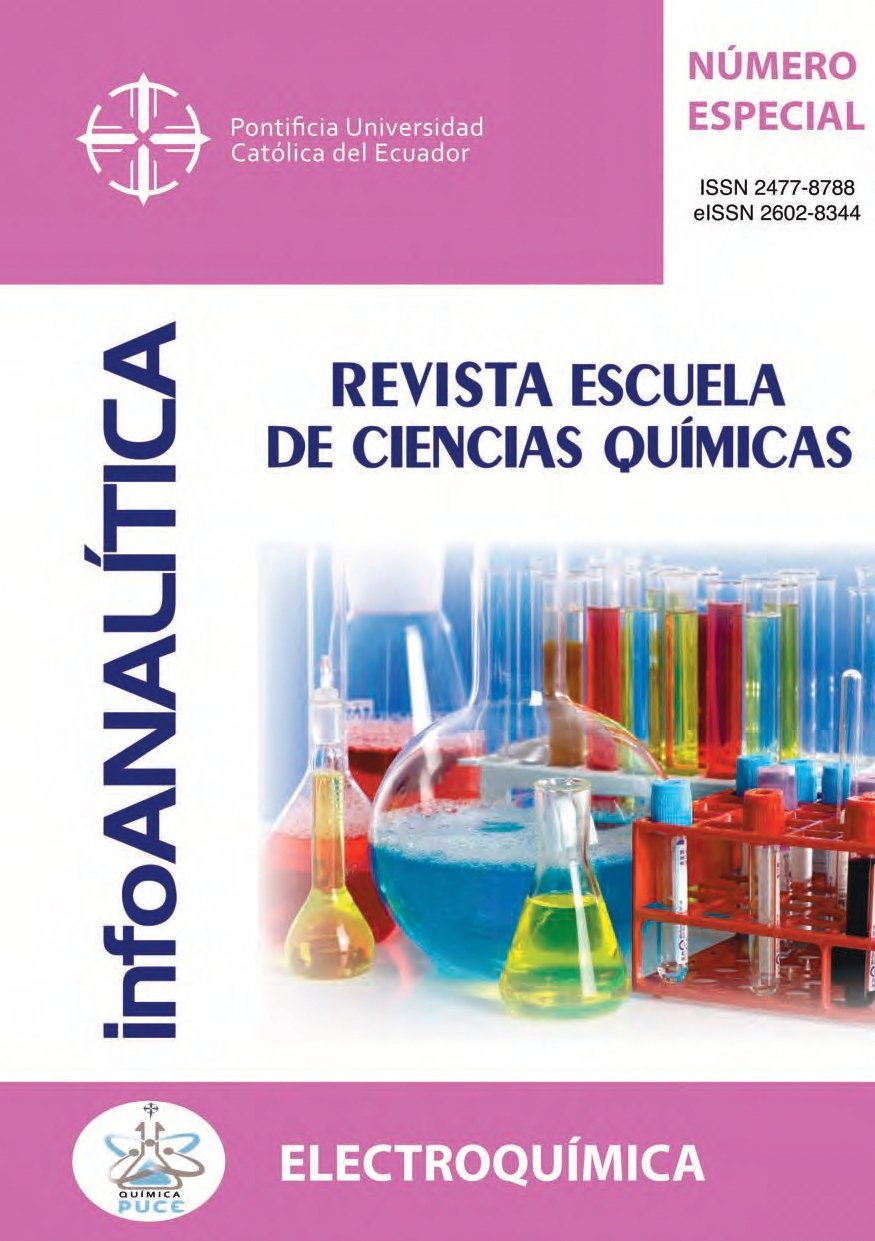Non-linear fitting of electrochemical techniques
Main Article Content
Abstract
Data analysis made with non-linear fitting are not very common, a possible cause is the inaccessibility to specialized software that require license as Zview® or DigiElch. Electrochemical techniques are useful for the determination of kinetics, thermodynamic of cells parameters. The non-linear fitting can be made using Solver into a spreadsheet of Microsoft Excel. This paper present two electrochemical techniques as examples of the developed methodology. Values of area and heterogeneous electron transfer rate constant were calculated from chronoamperometry and cyclic voltammetry of hexacyanoferrate(III) onto platinum ultramicroelectrodes.
Downloads
Article Details
- The authors agree to respect the academic information of other authors, and to assign the copyrights to the journal infoANALÍTICA, so that the article can be edited, published and distributed.
- The content of the scientific articles and the publications that appear in the journal is the exclusive responsibility of their authors. The distribution of the articles published in the infoANALÍTICA Journal is done under a Creative Commons Reconocimiento-CompartirIgual 4.0 Internacional License.
References
Metals by flame atomic absorption spectrometry (2018). In Standard Methods For the Examination of Water and Wastewater. American Public Health Association. https://doi.org/doi:10.2105/SMWW.2882.043
-N nitrogen (2018). In Standard Methods For the Examination of Water and Wastewater. American Public Health Association. https://doi.org/doi:10.2105/SMWW.2882.086
-P phosphorus (2018). In Standard Methods For the Examination of Water and Wastewater. American Public Health Association. https://doi.org/doi:10.2105/ SMWW.2882.093
chemical oxygen demand (COD) (2018). In Standard Methods For the Examination of Water and wastewater. American Public Health Association. https://doi.org/doi:10.2105/SMWW.2882.103
Aelterman, P., Rabaey, K., Clauwaert, P., & Verstraete, W. (2006). Microbial fuel cells for wastewater treatment. Water Science and Technology, 54(8), 9–15. https://doi.org/10.2166/wst.2006.702
Bassante, N. (2018). Evaluación del efecto de polímeros conductores en el tratamieno de aguas residuales domésticas utilizando celdas de combustible microbianas. Universidad Central del Ecuador.
Behera, M., & Ghangrekar, M. M. (2011). Electricity generation in low cost microbial fuel cell made up of earthenware of different thickness. Water Science and Technology, 64(12), 2468–2473. https://doi.org/10.2166/wst.2011.822
Buitrón, G., & Cervantes-Astorga, C. (2013). Performance evaluation of a low-cost microbial fuel cell using municipal wastewater. Water, Air, and Soil Pollution, 224(3). https://doi.org/10.1007/s11270-013-1470-z
Choi, S. (2015). Microscale microbial fuel cells: Advances and challenges. Biosensors and Bioelectronics, 69, 8–25. https://doi.org/10.1016/j.bios.2015.02.021
Do, M. H., Ngo, H. H., Guo, W. S., Liu, Y., Chang, S. W., Nguyen, D. D., Nghiem, L. D., & Ni, B. J. (2018). Challenges in the application of microbial fuel cells to wastewater treatment and energy production: A mini review. Science of the Total Environment, 639, 910–920. https://doi.org/10.1016/j.scitotenv.2018.05.136
Geissdoerfer, M., Savaget, P., Bocken, N. M. P., & Hultink, E. J. (2017). The Circular Economy – A new sustainability paradigm? Journal of Cleaner Production, 143, 757–768. https://doi.org/https://doi.org/10.1016/j.jclepro.2016.12.048
Hernandez-Fernandez, F. J., de Los Rios, A. P., Salar-Garcia, M. J., Ortiz-Martinez, V. M., Lozano-Blanco, L. J., Godinez, C., Tomas-Alonso, F., & Quesada-Medina, J. (2015). Recent progress and perspectives in microbial fuel cells for bioenergy generation and wastewater treatment. Fuel Processing Technology, 138, 284–297. https://doi.org/10.1016/j.fuproc.2015.05.022
Li, M., Zhou, M., Tian, X., Tan, C., Cameron, T., Hassett, D. J., & Gu, T. (2018). Microbial fuel cell (MFC) power performance improvement through enhanced microbial electrogenicity Ming. Biotechnology Advances, December 2017, #pagerange#. https://doi.org/10.1016/j.biotechadv.2018.04.010
Logan, B. E. (2007). Microbial Fuel Cells. John Wiley & Sons, Inc. https://doi.org/ 10.1002/
Logan, B. E., Hamelers, B., Rozendal, R., Schröder, U., Keller, J., Freguia, S., Aelterman, P., Verstraete, W., & Rabaey, K. (2006). Microbial fuel cells: Methodology and technology. Environmental Science and Technology, 40(17), 5181–5192. https://doi.org/10.1021/es0605016
Logan, B. E., & Rabaey, K. (2012). Conversion of wastes into bioelectricity and chemicals by using microbial electrochemical technologies. Science, 337(6095), 686–690. https://doi.org/10.1126/science.1217412
Rabaey, K., & Verstraete, W. (2005). Microbial fuel cells: Novel biotechnology for energy generation. Trends in Biotechnology, 23(6), 291–298. https://doi.org/10.1016/j.tibtech.2005.04.008
Rea, H. S. (2017). Evaluación de la biomasa producida por el tratamiento de aguas residuales domésticas usando celdas de combustible microbiano (MFCs) como posible abono agricola. Universidad Central del Ecuador.
Sacco, N. J., Figuerola, E. L. M., Pataccini, G., Bonetto, M. C., Erijman, L., & Cortón, E. (2012). Performance of planar and cylindrical carbon electrodes at sedimentary microbial fuel cells. Bioresource Technology, 126, 328–335. https://doi.org/https://doi.org/10.1016/j.biortech.2012.09.060
Sivasankar, V., Mylsamy, P., & Omine, K. (Eds.). (2018). Microbial Fuel Cell Technology for Bioelectricity. Springer International Publishing. https://doi.org/10.1007/978-3-319-92904-0
Wei, B., Tokash, J. C., Chen, G., Hickner, M. A., & Logan, B. E. (2012). Development and evaluation of carbon and binder loading in low-cost activated carbon cathodes for air-cathode microbial fuel cells. RSC Advances, 2(33), 12751–12758. https://doi.org/10.1039/C2RA21572A
Zhang, F., Cheng, S., Pant, D., Bogaert, G. Van, & Logan, B. E. (2009). Power generation using an activated carbon and metal mesh cathode in a microbial fuel cell. Electrochemistry Communications, 11(11), 2177–2179. https://doi.org/https://doi.org/10.1016/j.elecom.2009.09.024

